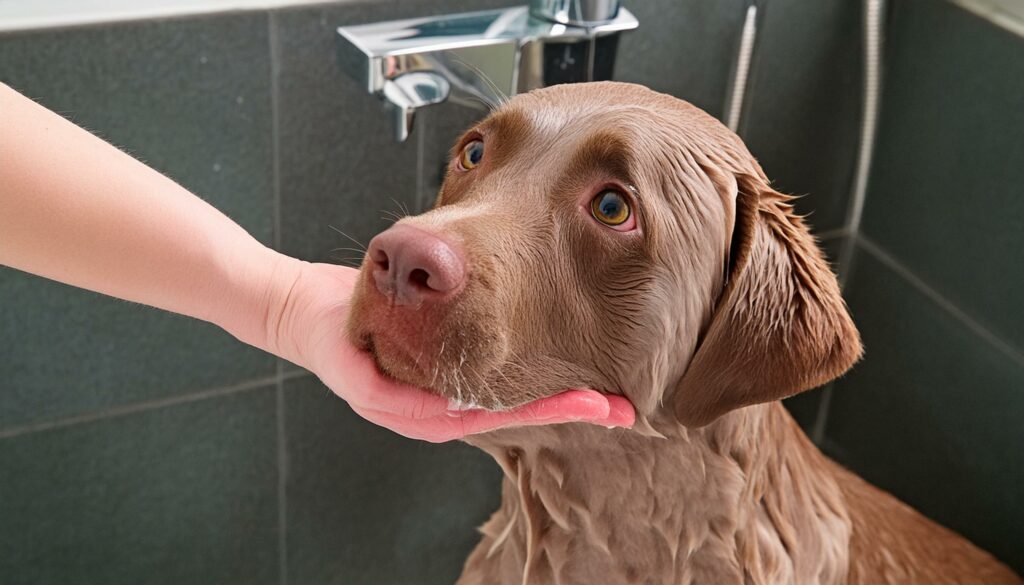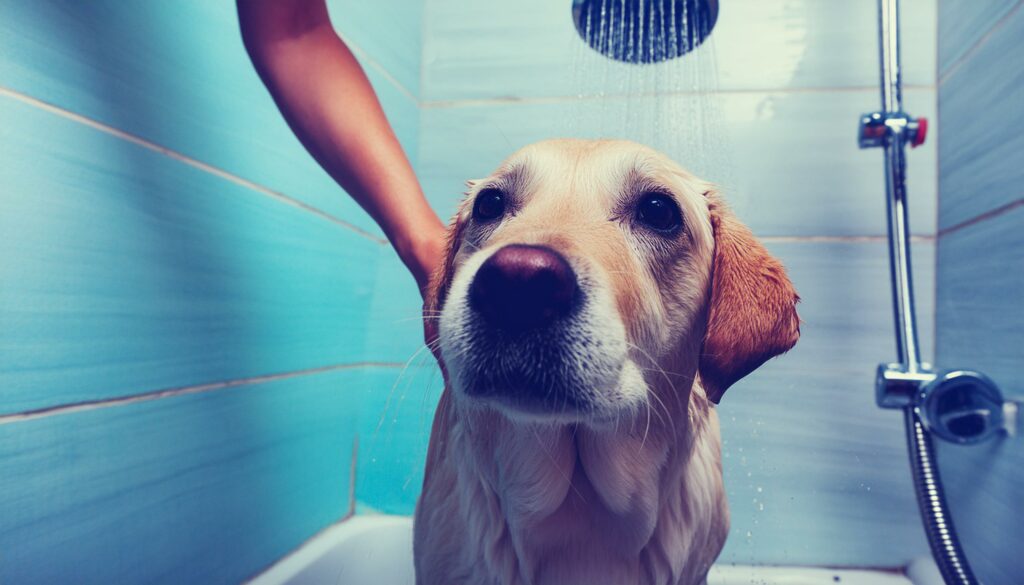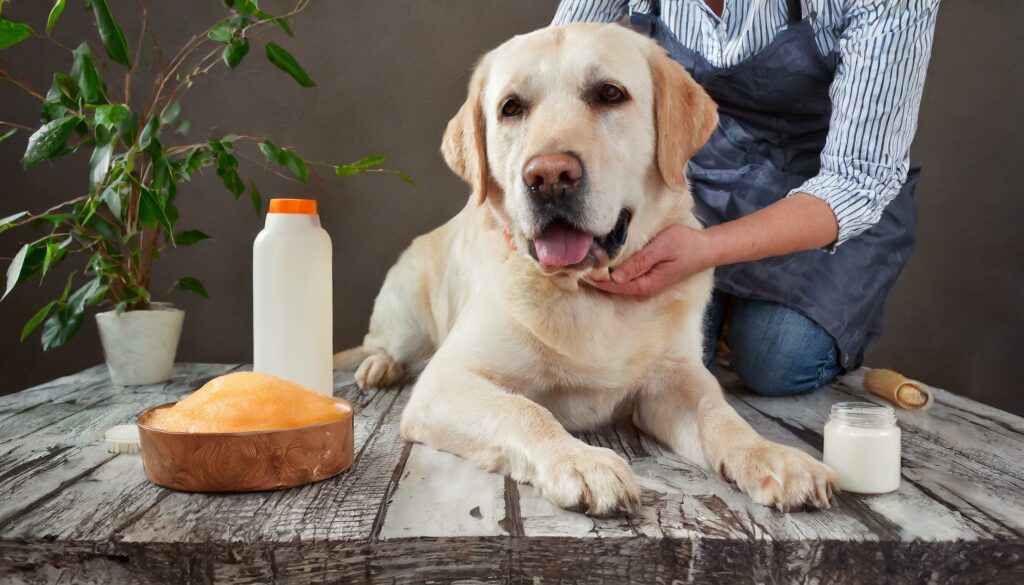Bathing your Labrador Retriever is an essential part of their health regimen that extends beyond mere cleanliness. It involves considerations about their skin health, overall comfort, and the strength of your bond. This guide explores the optimal bathing frequency for your Labrador, influenced by various factors from their activity levels to their age.
Understanding Your Labrador’s Needs
Skin and Coat Characteristics
Labradors are known for their distinctive double coat which includes a soft undercoat and a weather-resistant outer coat. This double layering is excellent for insulation and protection but also means that their grooming needs are somewhat specific. The breed’s coat is also designed to shed water, and as a result, they can often keep themselves relatively clean with minimal help. However, their coat also traps dirt and odors, which necessitates regular cleaning.
Factors Affecting Bathing Frequency
The need to bathe your Lab can vary based on several factors:
- Activity Level: Active dogs who spend a lot of time outdoors will likely need more frequent baths.
- Environment: Dogs living in urban areas may accumulate more pollution and debris in their fur.
- Health and Skin Conditions: Dogs with sensitive skin or allergies might require special bathing schedules to manage symptoms.
Benefits of Regular Bathing

Hygiene and Health
Regular bathing helps remove dirt, debris, and odors from your dog’s coat. It prevents the buildup of irritants that can lead to skin infections and helps manage the shedding of fur, keeping your home cleaner.
Bonding Time
Bathing is an excellent opportunity for bonding. It allows you to spend quality time with your pet, building trust and comfort through gentle handling and grooming.
Inspection for Health Issues
Each bath is a chance to check your dog’s body for any signs of health issues, such as bumps, lumps, or parasites, that might otherwise go unnoticed.
Risks of Over-Bathing

Skin Irritation and Dryness
Washing your Labrador too frequently can strip their coat of its natural oils, leading to dry, irritated skin. This can make your Lab uncomfortable and may lead to more serious skin conditions if not managed properly.
Damage to Natural Oils
The natural oils in your dog’s coat are essential for maintaining the health of the fur. Over-bathing can disrupt this balance, potentially leading to a dull coat and increased shedding.
Signs Your Lab Needs a Bath
Visible Dirt and Smell
The most obvious signs that your Labrador needs a bath include visible dirt or a foul odor. If your dog smells or appears dirty, it’s time for a bath.
After an Outdoor Adventure
Dogs that have spent the day hiking, swimming, or playing in muddy areas may need a bath to remove irritants from their coat.
Allergic Reactions
If your dog suffers from allergies, regular baths may help to remove allergens from their fur, which can reduce itching and discomfort.
Choosing the Right Products
Shampoo for Sensitive Skin
Opt for a high-quality dog shampoo that caters to sensitive skin. Avoid products with harsh chemicals that can exacerbate skin issues.
Conditioner for Coat Health
Using a conditioner after shampooing can help detangle and restore moisture to your Lab’s coat, keeping it healthy and shiny.
Natural Alternatives
For those who prefer natural solutions, consider homemade or commercially available natural pet shampoos that include ingredients like oatmeal or aloe vera, known for their soothing properties.
Bathing Frequency by Age
Puppies
Lab puppies may need frequent baths as they are prone to getting dirty through their exploratory behaviors. However, ensure that their skin is fully protected with puppy-specific shampoos.
Adult Labs
An adult Labrador typically requires a bath every 4-6 weeks, though this can vary based on the factors mentioned earlier.
Senior Dogs
Senior Labs may need fewer baths as they are less active, but their skin care should not be neglected, especially as they can be prone to dryness as they age.
Step-by-Step Bathing Guide

Preparation
Gather all necessary bathing supplies, ensure the water is a comfortable temperature, and place a non-slip mat in the tub to prevent slipping.
Bathing Process
Gently wet your Lab’s coat with warm water, apply shampoo, and massage it into the coat. Be thorough but gentle, ensuring not to get soap in their eyes or ears.
Post-Bath Care
Rinse your Lab thoroughly to remove all soap residues, which can irritate the skin if left behind. Dry them with a towel or a low-heat blow dryer, and make sure they are completely dry, especially in colder weather.
Dealing With a Water-Shy Lab
Gradual Acclimation
For Labs that dislike water, gradually introduce them to bathing. Start with just getting their feet wet and slowly increase their exposure.
Positive Reinforcement Techniques
Use plenty of praise and treats during and after the bath to create positive associations with bathing.
Drying and Grooming Post-Bath
Towel Drying
Use a soft, absorbent towel to gently dry your Lab. Pat rather than rub to avoid tangling their fur.
Use of Blow-Dryers
If using a blow dryer, ensure it’s on a cool or low heat setting to avoid overheating and frightening your Lab.
Brushing Techniques
Regular brushing after baths can help prevent matting and keep your Lab’s coat smooth and shiny.
Maintaining Coat Health Between Baths
Regular Brushing
Frequent brushing helps distribute natural oils throughout the coat, reduces shedding, and keeps the coat looking clean and healthy.
Diet for Skin Health
A well-balanced diet rich in omega fatty acids can promote a healthy coat and skin. Consider incorporating supplements if recommended by your vet.
Supplements
Supplements like fish oil can be beneficial for maintaining skin and coat health, especially in older Labs.
Professional Grooming vs. Home Bathing

When to Consider Professional Help
If you’re dealing with severe matting or skin issues, or if you simply find the task too challenging, it might be wise to consider professional grooming services.
Benefits of Professional Grooming
Professional groomers are equipped to handle the grooming needs of all dog types, including those with specific health or temperamental needs, ensuring a thorough and safe grooming session.
Common Mistakes to Avoid
Bathing Too Frequently
It’s crucial not to bathe your Lab too frequently to avoid stripping their coat of essential oils.
Incorrect Product Use
Always choose products specifically formulated for dogs and suitable for your Lab’s specific skin and coat type.
Conclusion
The key to determining the best bathing frequency for your Labrador lies in understanding their individual needs and lifestyle. Monitor their skin and coat condition regularly and adjust their bathing schedule as needed to ensure they stay healthy and happy.
